Matador Network's Blog, page 590
September 16, 2021
Move over AmEx: Capital One and Chase are entering the airport lounge game

For many years now, American Express has dominated the airport lounge game. The Centurion Lounges are heralded as some of the best lounges around, with custom cocktails, chef-inspired cuisine and comfortable spaces for relaxing before your flight. Until now, no other credit card offered a dedicated lounge outside of Priority Pass or lounge collections through third parties. Chase and Capital One are finally joining the party, albeit a bit late. Here’s what we know about Capital One airport lounges and the Chase Sapphire lounge.
Chase airport loungesChase is launching the “Chase Sapphire Lounge by The Club” collection managed by an operator of a number of airport lounges that you may be familiar with through Priority Pass: The Club. In general, The Club lounges are not the most remarkable out there, so it will be very interesting to see if Chase plans to compete with AmEx’s Centurion lounges.
The Chase Sapphire lounge locationsAs of today, there are three planned openings. Two are US-based and the other is international. You’ll soon find these new lounges in:
Boston Logan Airport (BOS) between Terminal B and Terminal CNew York Laguardia (LGA) Airport in Terminal BHong Kong (HKG) in Terminal 1At this time, there are limited details available as to what the lounge plans are and when they open, but we can expect to see them in late 2022 or 2023.
How to access the Chase Sapphire loungesHere’s where it gets interesting. From what we’ve read, access to the lounge will be through Priority Pass, meaning, anyone with a Priority Pass can access the lounge…including AmEx Priority Pass holders. That means, particularly for the US market, there will likely be some pretty big capacity issues. That also means that these new Chase lounges likely won’t be as premium or luxurious as AmEx’s owned and operated Centurion Lounges.
Capital One airport loungesIf you weren’t particularly aroused by the sound of the Chase’s managed by The Club airport lounges, you may be more excited to hear about the Capital One lounges that were announced this year. Capital One’s lounge announcement came with the promise of premium dining quality, a host of amenities and even Peloton bikes!
Unlike the Chase airport lounges, there is talk of unique features and amenities, like cold brew stations, local cuisine, craft cocktails and relaxation and yoga rooms.
The Capital One airport lounge locationsCapital One’s first airport lounge opening will be in Dallas at the Dallas-Fort Worth Airport (DFW) in Terminal D. This lounge is set to open at the end of 2021 and will be just steps from the AmEx Centurion Lounge, putting it in direct competition with them. Boasting 10,000 square feet, this lounge is determined to take on a share of the premium travelers market.
Two additional US-based Capital One lounges are set to open in 2022 in Denver (DIA) and Washington Dulles (IAD).
How to access the Capital One loungesWhile there is no real information on access and cost yet, there are rumors of an entrance fee depending on your credit card. Most of the Capital One credit cards come with a pretty low annual fee when compared to the now $695 annual fee on the AmEx so there is no surprise that access will come at a cost. They are, however, guaranteeing lower entry fees for particular cardholders. My bet? They may just be launching a new premium card of their own in the future to compete with the likes of the Chase Sapphire Reserve and Amex Platinum.
The bottom lineThe bottom line is that AmEx is no longer the only fish in the pond. Despite Chase’s somewhat disappointing sounding lounge network, there are now two additional competitors in the space competing for credit card business, particularly with the Capital One lounges. This may just push AmEx to increase their own locations to stay on top. Stay tuned for more details on opening dates and new locations. 
The post Move over AmEx: Capital One and Chase are entering the airport lounge game appeared first on Matador Network.
September 15, 2021
This new eco-friendly resort in Belize will have a secret beach and a private island

With the convenience of being just a couple of hours from the US, the amazing Central American culture, and the turquoise water abundant with fish and other animals, Belize is worth putting on your bucket list. And luckily enough, Six Senses, a hotel brand that centers on wellness and sustainability, is opening a Belize location, finished with a secret beach and private island.
The property is almost two miles long and will be split into two parts. It will house 45 villas and a few residences, along the gorgeous 18-acre beach Ambergris Caye. Five minutes by boat, (or you can even swim) is the private island where you’ll find secluded overwater bungalows, the spa, and other wellness facilities. Plans include organic gardens, a food market, a second pool, an overwater restaurant, and even a teen’s club. The Secret Beach will host watersports, a dive center, and a marine discovery section.

Photo: Six Senses
“Throughout, the emphasis has been placed on sensitive integration of landscaping to connect guests with nature and allow for greater privacy and coveted ‘desert island’ appeal,” said Chief Executive Officer Neil Jacobs in a press release. “We’ve drawn inspiration from local craft and Belizean life, capturing the spirit and history of Mayan architecture and local heritage. Everything has been done to embody a new generation of travelers, eager to make memories, while preserving the island for future generations.”

Photo: Six Senses
Six Senses has prioritized respecting the nature surrounding the property. It plans to protect the wetlands and mangrove forests, and the existing flora and fauna by making it a natural preservation area. The property will use renewable wood and passive solar strategies to lower the environmental impact, including solar panels for energy efficiency. The Green roof areas will be used for insulation. The company promises to leave the vegetation along the beach intact and hopes to re-vegetate red mangroves and plant species to preserve the beach and encourage biodiversity.
Six Senses Belize plans to open in 2025. And with a flight time of just an hour and a half from Miami, the island nation is definitely worth adding to your bucket list. 
The post This new eco-friendly resort in Belize will have a secret beach and a private island appeared first on Matador Network.
How to crush Miami’s Frost Museum of Science in one day

Like so many things in Miami, the Phillip and Patricia Frost Museum of Science is made to be photographed. America’s most aesthetically pleasing science museum is chock-full of Instagrammable moments, from its sprawling top-floor view of turquoise waters and glimmering towers, to its underwater windows bathed in soft blue natural light.
But unlike a lot of pretty things in Miami, the Frost Museum of Science has substance. A lot of it. Part aquarium, part science museum, it can teach you more about the ecology and evolution of South Florida in a few hours than some locals learn in a lifetime. And while it’s easy to get caught up in its beauty, taking time to delve into the Frost Museum of Science’s exhibits can be just as memorable. We took a deep dive with VP of Animal Husbandry and Marine Conservation Andy Dehart and Director of Animal and Museum Exhibits Skip Uricchio, and they showed us how to make the most of your time at the Frost Museum of Science.
The #1 piece of advice for visiting the Frost Museum of ScienceThe best times to visit the Frost Museum of ScienceWhere to start your Frost Museum of Science visitHow long you should budget to visit the Frost Museum of ScienceWhere to eat at the Frost Science MuseumThe five best things to do at the Frost Museum of ScienceThe five exhibits you absolutely can’t miss at the Frost Museum of ScienceThree underrated areas you should visit at the Frost Museum of ScienceWhat you can skip at the Frost Science MuseumThe #1 piece of advice for visiting the Frost Science Museum
Photo: Frost Science/Facebook
Since there’s a lot of ground to cover at the Frost Museum of Science, and planetarium shows tend to sell out during busy times, you’ll want to book your show in advance, and plan your day around that.
“If you do online ticketing, you usually get the first shot at the planetarium shows,” says Dehart. “They’ll give you your choice of time slot, and what show you want to watch. And if you can get that done right out of the gate you can take your time exploring and not worry about a showtime.”
The shows at the 67-foot, 360-degree planetarium include Worlds Beyond Earth; Dynamic Earth; and Phantom of the Universe: The Hunt for Dark Matter. Admission is included in your Explorer Ticket.
The best times to visit the Frost Museum of ScienceThe best time to go to avoid crowds, according to Dehart, is right around when school starts up, towards the end of August and into September. Is that also the hottest, muggiest part of the year in Miami, and may necessitate a change of shirts when you visit the outdoor exhibits? Maybe. Just stay hydrated and you’ll be fine.
As one might expect in Florida, the busiest times at the Frost Museum of Science are around the holidays in December and January, and spring break in March and April. And if that’s the only time you can make it, both Dehart and Uricchio stressed that coming early is crucial. The museum opens at 10 AM daily, and in addition to that being the emptiest time it’s also the coolest.
Where to start your Frost Museum of Science visit
Photo: Frost Science/Facebook
To see the museum properly, the first thing you’ll want to hit is the Royal Caribbean Vista on the fourth floor. It looks out onto Biscayne Bay and the city skyline, and down into the aquarium’s tanks. But once you’ve had your fill of the top floor, the Frost Museum of Science is best visited as two different spaces.
“I typically tell people to go up to the fourth floor of the aquarium, at the Royal Caribbean Vista, first, and work their way down,” says Dehart. “You’ll end up in the Power of Science, which has an aquarium component to it, then take the yellow elevators up and do the trick all over again. It’s like two cascading waterfalls.”
How long you should budget to visit the Frost Museum of ScienceEven though it’s effectively two museums, The Frost Museum Science can be done in about two and a half to three hours, even if you take your time. This can, however, be extended by excessive selfie time, which will be a lot more than you think if you’re visiting with kids who own cell phones.
Where to eat at the Frost Science Museum
Photo: Frost Science/Facebook
Just before you exit the museum, you’ll spot Food@Science, the Frost Science Museum’s café. The menu is surprisingly varied, ranging from pizzas to Mexican street corn to veggie power bowls. You can even get a little taste of the city here, with the Miami bowl and its pollo a la plancha, beans, and rice. There are also healthier options like mezze salad or beyond burger. And beer and wine, if a day chasing kids around the museum calls for a drink.The five best things to do at the Frost Museum of Science1. Gaze down into tropical coral reefs from the top floor
Photo: Frost Science/Facebook
Aquariums the world over allow you to look in on the undersea world, where colorful fish swim past you behind a thick glass wall. Few, however, let you peer down into the undersea world. Standing atop Frost Science’s fourth floor, you’ll be at the surface of the Gulf Stream, a 100-foot, 500,000-gallon tank where shark fins cruise the surface with the Miami skyline in the background.
A few steps from the Gulf Stream you can look down into an artificial coral reef, meant to replicate the reef just off the South Florida shore. You’ll see into a world of colorful, tropical fish enticing you to delve deeper into the museum, and similarly see them from below.
2. Take a picture at the Oculus
Photo: World Red Eye / Frost Museum of Science
If there is one iconic, Instagrammable moment at Frost Science, it’s the Oculus. This 31-foot circular window at the bottom of the Gulf Stream allows visitors to stare up into the underwater world, where hammerhead sharks, manta rays, mahi-mahi, and 7,000 shiny bait fish make for one of the most mesmerizing views in American museums. The eerie blue lighting juxtaposed against the natural light coming from above also makes it an ideal place for pictures. And you’ll find tourists, photographers, and influencers queueing up for their turn in front of the window.
Is it a little cliché? Sure. But kinda like taking a picture in front of the Eiffel Tower in France, if you haven’t been before, you kinda have to.
3. Take a load off at the planetariumWhile the Royal Caribbean Vista and the Oculus may be the social media stars of the Frost Museum of Science, its most recognizable exterior feature is its massive planetarium. Its shows are all captivating and educational, but Frost’s planetarium also affords visitors the opportunity to do something else critically important: Cool off.
Miami, in case you weren’t aware, can get warm. And much of the best stuff at Frost is outside. The planetarium, however, is refreshingly air-conditioned, and the 20-25-minute shows serve as a welcomed chance to relax and recharge.
4. Pet a stingrayOn the museum’s top floor, you’ll find a large tank of Atlantic and Southern rays sitting on the far eastern end, right near the wall. This is the Florida Bay Touch Experience, where kids and kids-at-heart can take their turn safely petting one of the ocean’s coolest-looking creatures. For those concerned about the ethics of touching an animal that may not have a choice, Dehart assured us the rays are only pet when they want to be.
“The experience is designed so that the rays really have to choose to be touched,” Dehart says. “It’s deep enough that people can’t just reach down and touch them. If the rays don’t want to be in that contact zone, they’re not. Some of them will, and some of them won’t.”
5. Immerse yourself in the virtual gulf stream
Photo: Frost Science/Facebook
Beautiful and massive as the Gulf Stream exhibit is, it still can’t give you a fully immersive experience inside the ocean. For that, there’s the virtual gulf stream, a 55-foot-wide by 10-foot-tall circular screen, that puts you in the middle of jellyfish, sharks, and even the occasional whale.
But this is no simple movie projection. As you move through and touch the screen, schools of fish and large creatures react to your presence, just as they might if you were swimming among them. You’ll learn the animals’ behaviors both with each other, and interacting with other creatures. The experience is made even more immersive by top-quality surround sound.
The five exhibits you absolutely can’t miss at the Frost Science Museum1. Gulf Stream Aquarium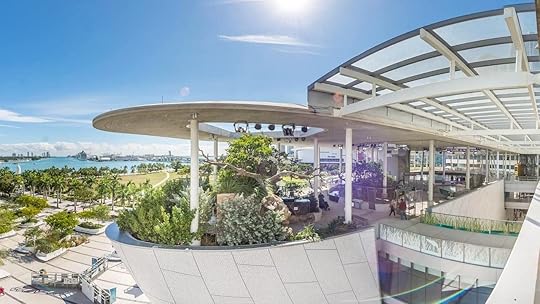
Photo: Frost Science/Facebook
Standing atop the “giant martini glass” — so named because of its conical shape — might be one of the best vantage points of Downtown Miami. But the exhibit includes animals that people travel the world to see, from Eagle Rays to Hammerhead Sharks to mahi-mahi. And you can view it from three different levels throughout the museum.
In addition to showcasing the creatures that live in the current off the Florida coast, the Gulf Stream is also designed to educate visitors on the vastness of the ocean.
“We wanted to show it was kind of that wet desert, that wet kind of middle of nowhere,” says Dehart. “If you jumped off a boat on your way to Bimini halfway across, this is what you’d see.”
2. Everglades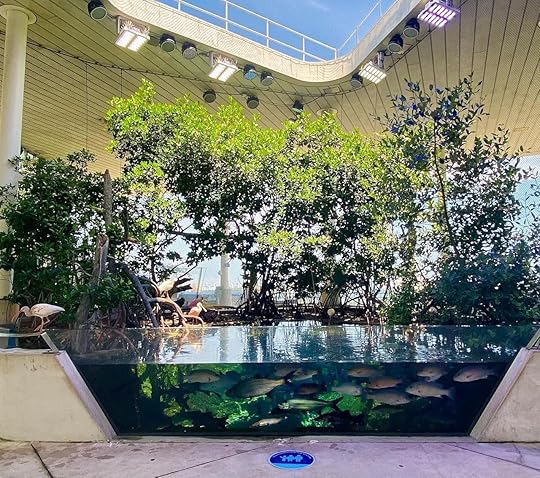
Photo: Frost Science/Facebook
Obviously, the best way to visit the unique and heavily endangered ecosystem of the Florida Everglades is to drive about 45 minutes west of Miami to Everglades National Park. But if you don’t have that much time — or insect repellant — stepping into the fourth floor aviary and Everglades habitat is a great way to learn about it.
Through red and black mangroves you’ll spot the impossibly rare Roseate Spoonbill, once hunted to near extinction for hat feathers. Creeping through the hardwood hammock, you’ll also see baby alligators and crocodiles, as the Everglades is the only place in the world you’ll find both. There are also owls, hawks, eagles, and plenty of snakes (behind glass, don’t worry). The birds are all part of rehabilitation programs, too, meaning they were found injured in the wild and were brought to the museum to recover.
3. The Dive and The Deep
Photo: Frost Science/Facebook
Descending down from the Royal Caribbean Vista level you’ll find yourself moving deeper into the aquarium tanks you just viewed from above. The third level, The Dive, includes dozens of small aquariums showcasing fish from around Florida and the world, including invasive species like the lionfish. There’s even a Pacific coldwater tank with a little red octopus.
Drop down another level and you’re in The Deep, where the light fades away and you meet deep-sea creatures you’d never see at diveable depths. It’s also home to two of the museum’s more memorable experiences — the immersive virtual gulf stream and the Insta-famous Oculus.
4. Feathers to The Stars
Photo: Frost Science/Facebook
No exhibit at the Frost Museum of Science is more thought-provoking as Feathers to the Stars, a look at how birds evolved to fly, and how humans used that evolution to propel ourselves into the sky. Inside you’ll be met with a 30-foot Yutyrannus huali, a feathered dinosaur that ultimately learned to fly. You’ll also see life-sized airplanes suspended from the ceiling, and have the chance to land a spaceship on Mars as part of the exhibit’s space section.
“Once you understand that story arc, the emergent evolution of flight of animals from dinosaurs to birds, then the evolution of flight from the Wright Brothers to the moon, it’s pretty cool,” says Dehart. “It’s probably my second favorite.”
5. Power of Science
Photo: Frost Science/Facebook
The final exhibit as you walk down to the ground floor is a masterful transition from aquarium to science museum. Here, visitors step into the shoes of scientific researchers, learning how theories are tested and experiments performed, with historic tools and interactive installations along the way. It examines four frontiers in science: Our oceans, bodies, environment, and universe. And it tells the stories of famous scientists who made breakthroughs in each.Three underrated areas you should visit at the Frost Museum of Science1. Observation deck and the sun spotBecause most journeys within the Frost Museum of Science start at the fourth floor Royal Caribbean Vista, few people ever visit the museum’s lush rooftop. But take the elevators up to floor six and you’ll be met with a terrace filled with native Florida beach plants, and a look at how solar energy is harnessed to help power the museum. You’ll find a good dose of Florida sunshine, so if you’re planning to spend some time up here, pack some sunscreen.
“It was originally part of our being a LEED [Leadership in Energy and Environmental Design] certified building,” says Uricchio. “But it’s all the native beach plants from right on the water, and we want people to see that they can have a really beautiful landscape using native plants that are more efficient.”
2. Wet Lab
Photo: Frost Science/Facebook
Hidden behind some nondescript doors on the museum’s seldom-visited fifth floor, you’ll find a sort of coral-incubation lab called the Wet Lab. Here, real-life scientists are working to restore 40 genotypes of coral, raising smaller specimens in tanks to hopefully replenish the dying reefs off Florida’s coast. “It’s kind of like the Noah’s Ark of Pillar Coral,” Dehart says with pride. While it’s not advertised as one of the museum’s main exhibits, it is open to anyone who pays admission.
3. River of GrassThis interactive children’s exhibit near the outdoor Everglades might be easy to write off as only for kids. But it can teach adults a lot. The immersive screen in the River of Grass’ main room lets visitors walk through a virtual Everglades, where Florida panthers dash by in the distance. Video-projected “water” reacts to your steps on the ground, and terrifyingly-large cartoon mosquitoes come out at sunrise and sunset, just like in the real Everglades.Just outside, a series of interactive water features show what happens to the Everglades’ water flow when we build roads and dams. And though it’s aimed at children, it’s an important education in water conservation that anyone can benefit from.
What you can skip at the Frost Science Museum
Photo: Frost Science/Facebook
The Frost Science Museum isn’t intimidatingly huge, so there’s no reason you can’t visit everything during one visit. But if you’re pressed for time, and you don’t have kids, you can probably give the MeLab a miss. While it’s an interesting look at how bodies work, and the impact of food and exercise on your health, it’s typically packed with kids and it can get noisy.
If you do have kids, understand every exhibit in the MeLab is highly interactive, so you may end up spending a lot more time here than you’d planned. Still, younger children will probably also find this more fun than the Power of Science. Our advice is to do both, but if you’ve got little ones with a short attention span opt for the MeLab instead. 
The post How to crush Miami’s Frost Museum of Science in one day appeared first on Matador Network.
Flight attendant explains why you shouldn’t lay on plane windows

There are a couple of no-nos when it comes to flying. For example, middle-seat etiquette and, during the COVID-19 pandemic, the importance of wearing the right mask on. But of course, there’s always something new to learn to stay safe and happy while you fly. On TikTok, flight attendant Tommy Cimato laid out a list of what he says you should never do on a flight under any circumstance, and it might make you think differently about airplane windows.
In the age of COVID, most of Cimato’s reasoning perhaps unsurprisingly comes from a sanitation perspective. If you have to use the bathroom, for example, don’t touch the flush button with your hands and instead use a tissue. Even though you (should be) washing your hands afterward, the whole thing is kind of gross when you think about it. He also says shorts are a no-no — pants are simply more covering. Even the coveted window seat, which is great if you like to look at the view, comes with problems. You might be tempted to rest your head to take a nap there, but Cimato insists you shouldn’t rest your head or nap on the window because you don’t know what a child, or adult, has smeared on it.
@tommycimato#greenscreen #fyp #flightattendant #airline #aviation #travel #flights
♬ Blue Blood – Heinz Kiessling & Various Artists
Cimato also recommends important ways to take care of yourself. Drinking water is super important, especially considering how easy it is to get dehydrated on long flights. It’s important to stay hydrated, and it’s good for circulation. And finally, Cimato says to utilize the flight attendants if you’re getting sick. Flight attendants are there to assist you with anything you might need, including a sick bag, so there’s no need to panic or do it all alone.
These tips for the most part don’t affect the people around you, but they are for your own good. 
The post Flight attendant explains why you shouldn’t lay on plane windows appeared first on Matador Network.
The happiest states in the US, mapped

Where you live is a determining factor of your overall level of happiness. Regardless of the universal feeling of pandemic fatigue, there are some US states that have fared better than others. What constitutes a happy life for an individual is not straightforward, so WalletHub set out to see which are the happiest and unhappiest states based on factors that can be scientifically measured.
In this study, WalletHub compared data all 50 states under three broad categories: emotional and physical well-being, work environment, and community and environment. It perhaps comes as no surprise that during the peak of the pandemic, four out of ten adults across the US reported systems of anxiety or depression. The group took into consideration 31 key metrics ranging from factors such as the state’s depression rate, level of unemployment, mean income, and the number of recorded positive COVID tests.
Source: WalletHubTop 10 happiest states
UtahMinnesotaHawaiiCaliforniaNorth DakotaSouth DakotaIdahoMarylandNew JerseyMassachusettsAmong the happiest states, New Jersey, California, and Hawaii have the lowest reported levels of adult depression, while Arkansas, Tennessee, Kentucky, and West Virginia are stated as being some of the unhappiest states with the highest levels of adult depression.
Top 10 unhappinest states
West VirginiaArkansasLouisianaMississippiOklahomaKentuckyTennesseeAlabamaAlaskaNew MexicoFor the full list of the happiest and unhappiest states and to check out where your state ranks, you can visit WalletHub’s website. 
The post The happiest states in the US, mapped appeared first on Matador Network.
Killer rock climbing in and around San Francisco
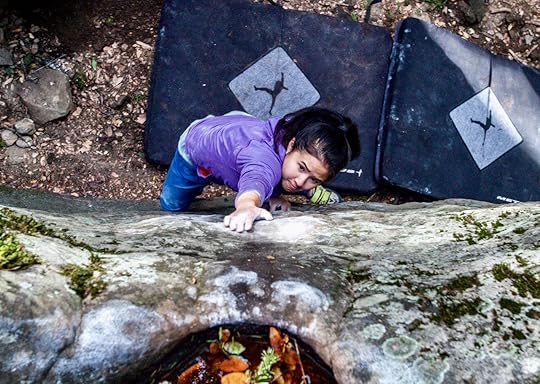
When people thinkof San Francisco, they think of the Golden Gate Bridge, sourdough, and Fernet. The city isn’t often thought of as an adventure destination — especially with Yosemite and Lake Tahoe so close by — but the San Francisco Bay Area holds adventure in its own right, and not just the foodie kind.
While it’s common for climbers to drive a minimum of three hours every single weekend in search of rocks, there’s rock climbing year round right in or next to San Francisco. In fact, elite professional climbers like Chris Sharma cut their teeth on the crags in and out of the Bay. So don’t sleep on San Francisco climbing. With plenty of climbing locations within and around the city, you can get out for a few hours or a full day, and still be back to enjoy all the fun evening activities associated with being in a large urban area.
A quick note: The Bay Area crags listed below can largely be navigated with Mountain Project. If you prefer physical copies of topo maps and routes, the best books are Bay Area Rock by Chris Summit and Bay Area Bouldering from SuperTopo.
San Francisco climbing
Photo: Eric Broder Van Dyke/Shutterstock
Within the city, Glen Canyon Park offers a handful of boulders for a solid few hours’ worth of climbing. Legend has it that many of the great Bay Area stonemasters trained here. The rock is radiolarian chert, layered sediment that lends itself to great incut jugs — meaning holds big enough to fit your hand inside. It’s a great spot to stop before or after work, or if you’ve got plans later in the day but you still want to get a workout in. The classic climb here is the Natural Act, V3, a highball reminiscent of the Buttermilks in Bishop. Getting there:Glen Canyon is easily accessible by BART, MUNI, or various ride-share apps.
Climbing in the East Bay
Paulina Dao
Climbers don’t have to venture across the bridge to climb on real rocks either. Across the Bay, Indian and Mortar Rock, and Cragmont offers an abundance of climbs, ranging from easy to difficult. These crags are a crucial part of Bay Area climbing history, as it’s here that many crusty climbers trained for the soaring walls of Yosemite.
Cragmont’s taller walls make it a suitable place to learn to climb on a rope, or to practice various climbing skills. Indian Rock and Mortar Rock, on the other hand, have long since been the Bay Area’s destination for challenging “problems,” as boulder routes are called. Anything graded above V10 is very difficult, and some of the problems here are a V13.
Indian Rock contains the most moderate climbs, while Mortar Rock contains primarily difficult problems. Many opt to warm up at Indian Rock before walking the three minutes to Mortar Rock to project; that is, to plan and execute a climb that may take a long time and many iterations to successfully complete.
Mortar and Indian Rock receive lots of traffic from the Bay Area and visiting climbers. You may not need to bring your crash pad, as there’s often so many crash pads that the rocks resemble a climbing gym. Classic climbs at Indian Rock include Beginner’s Face, Pegboard, and the spooky highball, Center Overhang. At Mortar Rock, must-dos include The Ramp and Black Plague.
The volcanic nature of the rock makes it an ideal climbing destination after it rains. The boulders dry out much more quickly and are less likely to break. These crags are located primarily in residential neighborhoods with little or no amenities. Climbers will need to make the short walk to Solano Avenue to relieve themselves. Getting there: Each of the parks are within an hour’s walk from BART, or accessible via ride-shares.
Climbing in the North Bay
Paulina Dao
Just north of the Golden Gate Bridge in Marin County, Ring Mountain is an ideal place for newby climbers to get their fix. Composed of blueschist rock, Ring Mountain is accessible for newer climbers with easy boulder problems and even easier roped terrain. The main boulders are Split Rock, which is visible from the parking lot, and Turtle Rock, a short 10-minute hike away. Set up a top-rope anchor on Split Rock, or treat it as a highball boulder problem. Most of the climbs on this rock are easy with a walk-off the back to get down.
If heights aren’t your thing, make the walk to Turtle Rock, where most of the climbs are moderates V2 and under. If it looks like you can climb it, it’s probably been done. There are handfuls of variations and traverses from one problem to another. The easy climbing on Turtle Rock makes Ring Mountain an incredibly beginner-friendly Bay Area climbing destination.
Even if you don’t feel like climbing, this spot gives you 360-degree views of the north end of the Bay Area. It’s absolutely stunning. Getting there:You can reach Ring Mountain with ride-sharing apps, and there’s cell service to get you back. A bus can get you across the Golden Gate Bridge; if you have a bike, pop it on the bus bike rack and ride it the final stretch from the Corte Madera stop to the Ring Mountain Preserve.
South Bay climbing
Paulina Dao
If you’re located in the southern portions of the Bay Area, Castle Rock State Park is the premiere destination. Castle Rock and the surrounding areas have a little bit of everything for everyone, from roped climbs to boulders. This area is significant in rock climbing history with old-school climbing legends, putting up difficult first ascents and test pieces. The grading here is notoriously sandbagged, with routes often much tougher to ascend than the numbers would suggest .
Castle Rock State Park is located in the Santa Cruz Mountains. Popular boulder problems at Castle Rock State Park include the Beak Traverse, the Spoon, Bates Problem, and Lost Keys Traverse. Popular roped climbs include Blowing Bubbles, Vicious Circle, and the Great Roof. Because Castle Rock State Park and the surrounding areas are all made of sandstone, make sure you wait at least 48-36 hours after it rains to climb. Sandstone is incredibly fragile and will break when it is wet. If it rained recently, please opt to climb at any of the other crags listed here.
Getting there:Castle Rock is accessible via ride-sharing apps, but will cost you an arm and a leg. Cell service is minimal, but available in certain spots to find your way home. Driving with your own or a rented car and sharing the cost with friends is the way to go.
Full-day climbing adventure at Pinnacles
Photo: stellamc/Shutterstock
For a full value day on ropes, head to Pinnacles National Park. It’s got a bit of adventure and spice. Note that the bolt spacing can be questionable with many runouts, or gaps between you and the next bolt, as the majority of routes were bolted from the ground up. Critically, the volcanic rock can be less than solid with cobbles prone to popping out from under your appendages at any given time. Classic areas include the Monolith and Discovery Wall, where cobbles are less likely to fall out because of the high traffic.
Unlike the other Bay Area crags, Pinnacles is the only destination with a climbing season. Late fall and winter provide the best temperatures for climbing; although winter can also bring rain. In the spring, many of the walls are closed for raptor nesting; which walls and routes are indicated on the Friends of Pinnacles website. Summer sees scorching hot temperatures, so only climb here during that time if you enjoy suffering and sunburn.
Whichever season you come, the park is incredibly beautiful and well worth the drive. Despite the soft rock and seasonal limitations, the towers that give the park its name, and the sheer quantity of climbing routes make this park a huge draw for climbers. The area has its own climbers guidebook, written before it was designated a national park, called Climber’s Guide to Pinnacles National Monument by Brad Young. 
The post Killer rock climbing in and around San Francisco appeared first on Matador Network.
7 luxurious airport hotels that’ll make you forget you’re right next to the runway
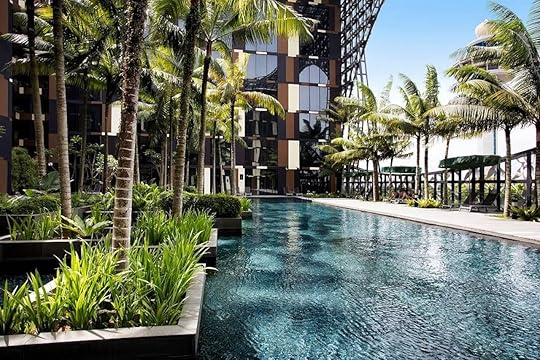
Some people judge staying at an airport hotel abroad similar to how they judge eating at a McDonald’s abroad. There’s a stigma that airport hotels have only the most basic essentials, lack character, and can’t possibly offer the same kind of cultural immersion you’d find in the city center — though the same can be said for many of the big chains in any city’s downtown that are just cookie-cutter clones of each other, anyway. Yet the desire for airport hotels to cater to discerning business travelers means that the accommodations are actually some of the coolest in the world. From New York City to Bahrain, these are some airport hotels where you won’t mind spending your long layover.
1. Crowne Plaza Changi Airport in Singapore
Photo: Crowne Plaza/Facebook
Singapore’s Changi Airport is internationally renowned for being one of the most technologically advanced and stylistically cutting-edge airports in the world. That flair extends to the airport’s Crowne Plaza hotel as well. Connected to all terminals of Changi Airport, the Crowne Plaza isn’t just incredibly convenient, but also aesthetically mind blowing. The landscaping alone will make you feel like you’re in a far off getaway instead of right next to the runway, and the nature-inspired rooms can transport you far away from the airport bustle. Apart from its relaxing aesthetic, the hotel also offers a club lounge, fitness center, fine dining at a Cantonese restaurant, pool, and spa.
2. Hilton Munich Airport in Munich
Photo: Hilton Munich Airport/Facebook
The Hilton at Munich Airport has all the amenities of an all-inclusive resort. Located within walking distance of Terminal 1 and 2, the hotel has a spa, heated indoor pool, the alpine-inspired Mountain Hub restaurant, and upscale cocktails at the Nightflight Bar. You won’t have to worry about being bothered by the air traffic outside either — in addition to soundproof windows with blackout curtains, the rooms also have courtyard, atrium, or garden views.
3. Hong Kong SkyCity Marriott Hotel in Hong Kong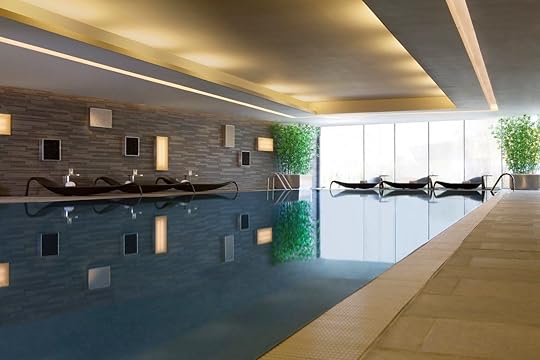
Photo: Hong Kong SkyCity Marriott/Facebook
The Hong Kong SkyCity Marriott has pretty much everything you could possibly want in a hotel. If it wasn’t three minutes from the airport, you’d think it was a spa retreat somewhere in the city center. The property has an indoor heated pool, 24-hour gym, and five on-site restaurants. From watching sports at Velocity Bar & Grill to taking afternoon tea at The Lounge, there’s a dining venue for every taste. Perhaps most welcome for long-haul travelers, however, is the Quan Spa, which offers facials, body scrubs, and massages.
4. W Abu Dhabi on Yas Island, Abu Dhabi
Photo: W Abu Dhabi/Facebook
Dubai may be most known for its opulence in the region, but when it comes to airport hotels, Abu Dhabi edges out its neighbor. While slightly farther from the airport than some of the others on this list at 10 minutes away from Abu Dhabi International Airport, the W Abu Dhabi is close enough to deserve a mention here. Just note it can sometimes look more like a nightlife complex than a traditional hotel. Home to several bars and restaurants, including a rooftop terrace with a pool bar and resident DJ, this hotel makes it easy to party in Abu Dhabi without venturing too far from the airport. The W is also located on a Formula 1 racetrack, and the rooms have floor-to-ceiling windows with views of either the track or the nearby marina.
5. Jumbo Stay in Stockholm
Photo: Jumbo Stay/Facebook
Jumbo Stay takes the “airport hotel” moniker a little too seriously. This five-star hotel is located inside a Boeing 747 Jumbojet directly adjacent to Stockholm’s Arlanda Airport. There are 33 rooms, including a cockpit and blackbox suite, and a room located inside the engine room. There’s also a cafe that resembles an airport lounge. To take the theme even further, hotel staff wear cabin crew uniforms and amenity kits include luggage straps inscribed with the hotel’s logo.
6. TWA Hotel in New York CityIMG: https://www.facebook.com/twahotel/pho...
Another aviation-themed airport hotel, JFK’s TWA Hotel is inspired by the golden age of air travel. Located in the same building that housed the Trans World Airlines terminal back in 1962, the hotel is like a trip back in time with a distinctly vintage feel (but modern amenities). The hotel’s restaurants and bars are unlike any other, with the Connie Cocktail Lounge housed inside an old Lockheed Constellation airplane from 1958, and a retro food hall in the same space TWA travelers used to check in for their flights. Perhaps most exciting about this hotel, however, is the rooftop infinity pool and bar, where you can watch planes take off and land on one of JFK’s busiest runways.
7. Mövenpick Hotel in Manama, Bahrain
Photo: Mövenpick Hotel/Facebook
At first glance, the Mövenpick Hotel in Manama, Bahrain, looks like a Caribbean resort. Across from the Bahrain International Airport and just 10 minutes from the city center of Manama, the hotel is situated right on the edge of a lagoon lined with lounge chairs and umbrellas. It has its own beachfront and is surrounded by gardens, creating an off-the-grid beach vacation feeling. The hotel is also home to the European Rimal spa with 12 different treatment rooms, and the five-star Xenia bar and lounge with cocktails and live entertainment. 
The post 7 luxurious airport hotels that’ll make you forget you’re right next to the runway appeared first on Matador Network.
The 8 best New York City hotel bars to sip in ultimate luxury
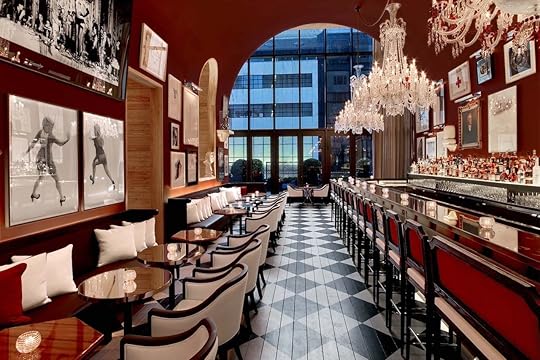
New York City has it all, whether you want to go on a grand museum tour, see a Broadway show, get your fill of global cuisine, or all of the above. The vibe also from neighborhood to neighborhood, from the prim and polished Upper East Side to the street-art covered warehouses of Bushwick. But one thing is a constant fact: New York is home to some of the most luxurious hotel experiences in the world.
Even if you prefer boutique accommodations or don’t have the budget to stay at one of these grandiose establishments, you can still put on the ritz for an evening and visit one of the city’s many luxury hotel bars. These eight hotel bars boast excellent bar programs, tasty snacks, and beautiful design.
1. The Mark Bar at The MarkThis chic Upper East Side hotel doesn’t take itself too seriously, and that’s exactly what makes it great. From the website’s playful illustrations to amenities like Jean-George picnics and special Woof Woof Kits for four-legged friends, The Mark is a special place. The Mark Bar is one of the best rooms in the hotel. The punchy space is designed with furnishings by Guy de Rougemont and Vladimir Kagan, and the seats are occupied by stylish folks seeking a pre-dinner drink or post-theater nightcap. Stop in for The Mark Cocktail, a bubbly delight made with Prosecco, lychee, and raspberry.
——
2. The Bar at Baccarat Hotel
Photo: Baccarat Hotel
Opulence touches everything at this Paris-inspired hotel, where you can order Champagne to your room with the press of a button and admire the Baccarat crystal decor glistening around every corner. Even if you’re not experiencing pied-à-terre living at Baccarat Hotel with an overnight stay, you can sip in the most luxurious fashion at The Bar. The space is New York and Versailles at the same time, with dark leather seats, a checkerboard floor, and stunning red crystal chandeliers. Try the Jade Moon — a mix of gin, jalapeno, sake, cucumber-mint foam, Thai basil, and lime — or splurge on the Baccarat Old Fashioned, which features a ball of Angostura cotton candy that melts into the drink.
3. Jacques Bar at The LowellThe Lowell is known for its impeccable concierge service, tree-lined surroundings, and cushy rooms with wood-burning fireplaces. The hotel’s Jacques Bar is a neighborhood favorite, and you’ll often find locals sipping martinis and munching on bar snacks in the warm and inviting room. Kick back with a classic like a French 75 or boulevardier, or try one of the signature cocktails like La Piscine, a refreshing mix of Crémant d’Alsace, Aperol, and orange blossom water that will channel seaside living anytime of year. Order a snack from the raw bar if you’re feeling peckish, or satisfy a bigger appetite with the caramelized onion cheeseburger.
——-
4. The Palm Court at The Plaza Hotel
Photo: The Plaza – a Fairmont Managed Hotel
This iconic New York institution has been welcoming guests to its Central Park South location for more than a century, so it’s certainly worth a visit even if you aren’t staying in one of the elegant rooms. The Palm Court at The Plaza serves a fabulous afternoon tea with towers of finger sandwiches and pastries, but you’ll want to settle in for evening cocktails. Take a seat at the bar, where you can admire ceiling-high palm trees and a magnificent stained-glass dome overhead. Try the signature Imperial Plaza, a bubbly mix of apricot eau de vie, brut Champagne, honey, and lemon juice.
5. The Bar Room at Beekman HotelThe facade of 5 Beekman Street was declared a New York City landmark in 1998, and the stunning Beekman Hotel opened there in 2016. Designer Martin Brudnizki restored the building to its former glory, and there’s no better place to experience its splendor than sipping a cocktail in The Bar Room at Temple Court. Take a seat underneath the nine-story pyramidal skylight and admire its Victorian grandeur while you contemplate your drink order. The Bar Room’s Vesper is the best in town, but the signature cocktails shouldn’t be overlooked. Spring for the 6pm in Osaka, which is made with Haku vodka, Luxardo Bitter Bianco, passionfruit, orgeat, grenadine, and lemon.
——-
6. The Crosby Bar at Crosby Street Hotel
Photo: Crosby Street Hotel
Fans of English elegance will love the Crosby Street Hotel, which features charming, colorful design and fabulous one-of-a-kind rooms. The Crosby Bar is one of Soho’s most beloved watering holes. Here, New Yorkers mix with out-of-towners from early morning breakfasts to last call. Pick a seat at the bar, on one of the brightly striped banquettes, or, weather permitting, outside on the verdant terrace. Order the Peppers & Peach (a sweet-spicy mix of reposado tequila, peach nectar, lime, and red chiles) while you munch on bar snacks like the tomato, mozzarella, and basil flatbread.
7. The Living Room at Park Hyatt New YorkIt’s difficult not to fall in love with Park Hyatt New York, which has an air of chic, serene luxury and understated elegance. Take the elevator up to The Living Room, which kind of feels like someone’s very fancy Manhattan apartment, for some of the best cocktails in the neighborhood. Pull up to the bar for the best seat in the house, where you can take in floor-to-ceiling window views and watch the talented bartenders at work. The drink menu changes seasonally, but you can always expect perfectly made classic and signature cocktails, along with thoughtful non-alcoholic drinks as well. The Bamboo (made with sherry, dry vermouth, and an Italian fortified wine) never disappoints.
——-
8. Salon de Ning at The Peninsula New York
Photo: The Peninsula New York
The Peninsula New York is the definition of luxury with its architecturally-stunning facade, grand staircase, and five-star spa. For dramatic skyline views, ascend to the rooftop bar Salon de Ning, which features two outdoor terraces and a handsome interior bar. Try the Pop Fashion, an old fashioned variation with popcorn-infused Maker’s Mark and salted caramel simple syrup. During the winter months, the space is transformed into Chalet de Ning with two après ski-inspired domes that will keep you warm as temperatures drop.
The post The 8 best New York City hotel bars to sip in ultimate luxury appeared first on Matador Network.
Haunted houses to rent on Airbnb

September is the unofficial start of the fall season. And besides the fact that leaves are starting to change colors, and that pumpkin spice is making its way back onto the beverage scene, this is the time of year when everyone gathers up their courage and visits locations that are infamous for horror- and haunted-related associations. If you’re willing to take things one step further and truly test the limits of your bravery, staying in a haunted Airbnb is a surefire way to have a spooky experience. From a Victorian home in Canada to a manor in Germany, here are eight haunted Airbnbs you can rent this fall.
We hope you love the spaces and stays we recommend! Just so you know, Matador may collect a small commission from the links on this page if you decide to book a stay. Listed prices are accurate as of the time of publication. See our full Advertiser Disclosure here.
1. The Haunted House — Penetanguishene, Ontario
Photo: Airbnb
This impressive Victorian home was once the home of Canadian lumber magnate Charles Beck, who in addition to effectively creating the town of Penetanguishene, also opened the first box factory in Toronto. Beck’s wife died leaving him with nine children, the oldest of whom, Mary, did most of the child-rearing. When Beck died, he only left poor Mary a dollar, and guests and residents of these apartments have reported seeing a tall man in a suit and an angry woman in a blouse standing in the hallways. Perhaps they will join you for the weekend when you rent Brenda’s meticulously furnished two-bedroom apartment, complete with period pieces, ornate rugs, and a warning about wandering spirits.
Four guests, two bedrooms
Price: $113 per night

Photo: Airbnb
The Inspiration House has an almost-tangible sense of the paranormal, with an entire display room on the first floor devoted to ghosts and the afterlife. You are welcome to tour it by request, though it’s usually closed because many guests found it “creepy.” Equally creepy are the heavy boots and floor scratching people have reported hearing upstairs, as well as the musical instruments in the living room that often decide to play themselves. Typically, this three-bedroom house near the center of Oberlin is used for meditation and spiritual retreats. But here, they mean your retreat might also involve actual spirits.
Seven guests, four bedrooms
Price: $220 per night

Photo: Airbnb
If you’re staying in a remote castle somewhere in northern Germany, owned by a Danish Countess and lit mostly by candlelight, you’d be pretty disappointed if the place wasn’t haunted. The foundations of this manor date back nearly 1,200 years, and you’ll be staying in a niche apartment within the manor’s walls. Christina — your host — lives in the manor as well, and will gleefully explain how the house is believed to be haunted by the Slavic gods that the people of the area used to worship. The common areas also include vast libraries filled with centuries-old books and large green lawns filled with sheep.
Two guests, one bedroom
Price: $136 per night

Photo: Airbnb
This home a few minutes outside Troy has such a distinct look it’s been used as a filming location for movies and TV shows, most recently for the feature film Fado. The interior is artful and eccentric, with hardwood floors, restored antique wallpapers, and conversation-provoking art on the common area walls. It’s also allegedly haunted, so much so that one of the individually rentable rooms is called the “Haunted Bedroom,” presumably so you can’t ask for your money back if you end up sharing the place with an uninvited apparition. If a ghost does show, there’s an easy escape as the Haunted Bedroom offers access to the third-floor attic. Though no guarantees there either.
Two guests, one bedroom
Price: $261 per night

Photo: Airbnb
Photographed from the right angle, this 1883 stone home looks like it could be a poster for a haunted house anywhere. So it reasons the ghost of Rosalia Finh, who died here as a child of typhoid fever, would be hanging around the hallways over a century after she passed away. Sean, who runs the place, claims to have found an old hair beret on the ground when he first moved in, and got an intense vision of a young girl in a white dress when he picked it up. Other guests have reported feeling a strange energy when standing outside the closet in Rosalia’s bedroom. Perhaps the best authority on the home’s spirits, however, is Scorch, Sean’s 9-year-old Doberman and head of security who may seem to be barking at nothing, but may just see a vision that you don’t.
Four guests, one bedroom
Price: $78 per night

Photo: Airbnb
The whited-out guest suite in this 1940s home has its own separate entrance, which may be why despite reports of glowing orbs, a self-playing music box, and lights that turn themselves on and off, none of it has ever happened in the guest areas. Ghosts, apparently, aren’t so good with code locks. Host David, however, will give you a ghost tour of the house if you’d like, since the spirits don’t bother the short-term guests. The house was originally built by David’s great-grandfather and he is the fourth generation to live in it. His listing offers no theory on who the ghosts might be or why they’ve moved in, but a few nights here might give you some ideas.
Two guests, one bedroom
Price: $64 per night

Photo: Airbnb
At this Airbnb in Talliston, you’ll have a private room in a house that just radiates ominous vibes. The home itself was featured on the documentary Britain’s Most Extraordinary Homes and we can see why. The master bedroom you’ll be staying in recreates that of an Edwardian child, with children’s toys and books lying around, and it’s the stuff of nightmares. Dark, imposing, and close quarters, staying here will require nerves of steel. And that’s not to mention the unexplained smells and sounds coming from the walls, as well as the ocean sounds coming from just outside the bedroom window. 
Two guests, one bedroom
Price: $173 per night
A version of this article was previously published on October 7, 2019, and was updated on September 4, 2020, and again on September 14, 2021, with more information.
More like thisEntertainment8 serial killer tours for the true-crime obsessedThe post Stay at these 8 haunted Airbnbs for a truly terrifying Halloween night appeared first on Matador Network.
The ultimate guide to LGBTQ travel in Eastern Europe

Eastern Europe offers travelers a taste of the former Soviet Union, with babushkas hawking caviar by the kilo in bustling market halls and grand incense-fogged Orthodox churches. Hidden behind the Iron Curtain until 30 years ago, today there are many gay friendly places in Eastern Europe for travelers to explore.
But there is another side to Eastern European travel for the LGBTQ community. We need to keep in mind that gay rights and the general perspective of the people toward queer folx in the region is really quite retrograde. Spending time in Eastern Europe often feels a little like stepping back in time, to the era before equal rights, gay marriage and the general acceptance of LGBTQ people.
Though being gay is technically legal in all of the countries we are looking at in this guide, the reality on the ground might make you question this. The largely conservative populations of Eastern European countries aren’t always open-minded, and many people have never been exposed to queer folx. But this is changing — albeit very slowly — and LGBTQ visibility in these countries may just further the cause for equality.
General advice for travel in this regionMy personal advice is to be a little more discreet. If being discreet is something you can’t stomach, it might be worth sticking to the most gay friendly places in Eastern Europe on the list. In most major cities, you’re unlikely to have issues sharing a double room with your same-sex partner or friend, but in smaller towns and villages, you may come across issues. Public displays of affection between same-sex partners — especially two males — would most likely attract unwelcome attention, even in larger cities. And in certain countries — Russia, Ukraine, Romania, Georgia and rural Hungary — LGBTQ travelers should be cautious and make sure to do research before planning a trip to make sure any issues are minimized.
A perfect Eastern European adventure would ideally include both large cities and some smaller towns, so you can really get a taste of the culture. The problem here is that outside of large cities, gay and lesbian life is sadly nowhere to be seen. The internet is really the only way to make contact with other gay people, but using dating apps in Eastern Europe is strongly advised against. Because of this, it’s best to stick with trusted friends (and friends of friends).
There are easier places for LGBTQ travelers to explore, but what you’ll find here is a region of Europe that is culturally rich, complex, and illuminating. Here’s the lowdown on seven popular countries that are — despite their flaws — worthwhile travel destinations, ranked from the least to the most gay friendly places in Eastern Europe.
1. Russia
Photo: TTstudio/Shutterstock
The largest and perhaps most interesting country in Eastern Europe, Russia can be a complicated visit for many in the LGBTQ community. Nothing is ever what it seems — like those nesting matryoshka dolls that tourists buy in souvenir markets. When traveling in the Russian Federation, it’s best to keep in mind that since 2013, there has been a law in place that basically makes it illegal to engage in the “promotion of homosexuality to minors,” which they term “gay propaganda.” Unfortunately, the vague way this law is written allows it to be widely applied by the police. Even holding hands with a same-sex partner outside a school could potentially trigger arrest, so it’s wise to be cautious.
St. Petersburg and Moscow both hold yearly pride marches which have always been shrouded in controversy. Police often arrest LGBTQ activists now that they’re shielded by the gay propaganda law. Because of this, visiting Russia for gay pride is currently not advised. Nevertheless, fun times can be had at some safe spaces — mainly bars and clubs –including Central Station, which has locations in both cities, Blue Oyster Bar in St. Petersburg, and Mono Bar in Moscow.
My personal experience from traveling in RussiaMy personal impression from traveling around Russia is that most people keep to themselves and very few people go out looking for trouble, but you may notice some people staring. My partner and I were once denied a hotel room because it only had one bed, but this wasn’t common. The Transsiberian Express staff didn’t think anything of us rooming together, perhaps because the beds are singles on the train. Overall, it’s far from the most gay friendly place in Eastern Europe, but it’s an incredible place to visit.
2. Ukraine
Photo: Oleksiy Mark/Shutterstock
Ukraine and its capital Kyiv made me feel like I was immersed in a near-future sci-fi film, with soaring Orthodox towers and statues juxtaposed with gritty grids of socialist tower blocks. Kyiv isn’t bursting with safe LGBTQ spaces, but there’s LIFT, a gay dance club, plus many underground clubs such as Resident Advisor.
Kyiv is bustling and fascinating but in the western part of the country — very close to the Polish border — there’s the lovely college town of Lviv. A city of 700,000 people, Lviv is packed to the brim with history and stunning architecture. It’s also lively with many bars and restaurants, lending it more of a Western European feel due to its large population of students.
My personal experience from traveling in UkraineI found Ukraine to be warm and welcoming, although the locals do clock foreigners quite easily. “Don’t tell people this,” I was advised by a couple in their 20s that my partner and I were sharing a table with at a Kyiv Christmas market after we told them we were a gay couple. Nevertheless, this couple didn’t seem to mind that we are gay and we ended up chatting for another half hour before polite goodbyes. The clerk at the hostel we stayed at — Dream Hostel in Podil — didn’t bat an eye when we asked for a room with a double bed.
3. Georgia
Photo: vvvita/Shutterstock
Mountains and caves, the oldest wine growing region on earth and fascinating cities filled with unique wooden architecture and ancient stone towers, Georgia is an up-and-coming destination, partially because it allows visa-free travel for US citizens for up to 365 days.
The LGBTQ community of Georgia is currently facing harsh resistance from its largely conservative population and the leadership of the Georgian Orthodox Church. This year, yet another pride month was marred with violence, counter-protests and arrests.
Tbilisi has recently gained a stellar reputation as one of the globe’s top DJ scenes, with superstars flying in for endless nights at mega club and LGBTQ safe space Bassiani. There’s also Café Gallery, the kind of warm and welcoming space that every city needs, a gallery/café/bar/club that accepts all types of people, from gay to straight to trans, and from young to old.
My personal experience from traveling in GeorgiaThe spaces mentioned above embody one of the secrets of LGBTQ life in not-so-friendly places — the communities are usually quite bonded and highly supportive of one another, making Georgia, at least in safe bubbles, one of the most gay friendly places in Eastern Europe.
4. Hungary
Photo: Milan Gonda/Shutterstock
Hungary is grand, green, and impressive, and its capital, Budapest, is crammed with impressive buildings, scrappy ruin bars, and several monumental public spas with naturally warm spring-filled pools.
Although it’s known as one of Europe’s burgeoning party capitals, this reputation is changing. This is because Prime Minister Victor Orban has turned the clock back a few decades during his term by signing legislation that removes protections from transgender people. In 2021, he enacted further legislation that censors LGBT positive content from movies, books, or public advertisements, and severely restricts sex education in school, forbidding any information thought to “encourage gender change or homosexuality.” Though the law is similar to Russia’s anti-LGBTQ law, the public reaction has been very different as thousands joined this year’s pride march to protest the legislation.
My personal experience from traveling in HungaryHungary is a fascinating country and was recently on the track to become a lot more liberal, but Orban has set it back considerably. This doesn’t mean, however, that the people aren’t accepting, because in general, they are, even in this conservative society. In the countryside and in smaller towns, due diligence is recommended because the lingering anti-LGBTQ sentiment of Soviet times hasn’t completely faded away.
5. Romania
Photo: emperorcosar/Shutterstock
Mountainous and peppered with romantic storybook villages, Romania is also home to a heaving, enormous capital city — Bucharest. Romania’s urban centers feel very safe, but nevertheless, it is advised that public displays of affection should be avoided because many people — police officers in particular — still garner some homophobia. There’s an active struggle for LGBTQ equal rights in the country but progress is being made towards legalizing same-sex marriage with almost 50% of the population declaring support this year.
Bucharest and Cluj-Napoca are the safest cities for LGBTQ travelers. Thor’s Hammer is a warm and welcoming gay bar in Bucharest and Cluj, a college town, is an accepting and safe environment for queer folx, mainly because the town has a young population.
My personal experience from traveling in RomaniaI have never worried about travel in Romania and I’ve never felt any undue attention directed at my partner and I, but travelers should nonetheless exercise caution here. It is wise to contact the human rights non-profit Accept Association for advice on where to go and what to do before booking a trip.
6. Poland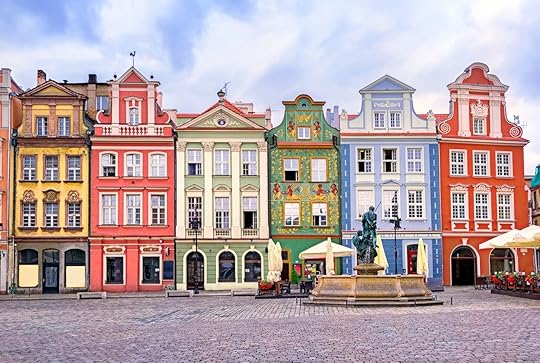
Photo: Boris Stroujko/Shutterstock
For LGBTQ travelers, Poland is a tale of two cities. In Warsaw and Krakow, gay people live relatively open lives, but when you leave the major cities, you find whole regions where there are literally no LGBTQ zones. But this isn’t to say that Poland isn’t progressing — in Slupsk on the Baltic Sea, the mayor is openly gay.
My personal experience from traveling in PolandPersonally, I have always found Poland to feel more akin to Germany rather than other places in Eastern Europe. With that being said, when in smaller towns and rural areas, I found it best to avoid undue attention by not displaying affection in public and requesting single beds in small hotels and inns.
7. Czech Republic
Photo: Veronika Galkina/Shutterstock
Much has been written about Prague, with its completely intact and charming old town, castles, thriving hipster and expat scenes, affordable prices, and mass tourism. It really is a special place and the Czechs are open and accepting to outsiders. Gay partnerships have been legal since 2006 and compared to the rest of the countries on this list, the Czech Republic is a virtual gay paradise. Here, LGBTQ travelers can still get a taste of that alluring former socialist Soviet feel but also feel relatively safe. Prague Saints, an LGBTQ travel agency, have an ongoing list of safe spaces and events that travelers can consult.
My personal experience from traveling in the Czech RepublicTo me, the Czech Republic feels more like Western Europe these days, and in truth, it was always in the far reaches of the Soviet Union’s influence. Today, LGBTQ travelers can feel like themselves, especially in Prague, but there may be some lingering strange looks in smaller towns and rural locations, so as always, use caution and maintain discretion. 
The post The ultimate guide to LGBTQ travel in Eastern Europe appeared first on Matador Network.
Matador Network's Blog
- Matador Network's profile
- 6 followers



